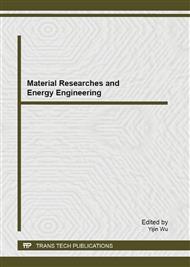p.275
p.281
p.287
p.292
p.297
p.303
p.309
p.313
p.319
Laboratory Experimental Research on Promoting Aquathermolysis of Heavy Oil with the NaNO2/NH4Cl Exothermic System
Abstract:
Concerning the fact that the in-situ aquathermolysis reaction of heavy oil is affected by the limit of formation temperature, a simulated experiment is made by means of thermochemistry on promoting the aquathermolysis reaction of heavy oil through increasing formation temperature via in-situ heat generation. The results show that after the injection of 5mL concentration of 5mol/L NaNO2/NH4Cl exothermic system to the reaction kettle, the reactor temperature rises from 200°C to over 240°C, increasing the pressure almost by 0.4MPa. After the reaction, the viscosity reduction ratio of the heavy oil decreases by about 40%, with saturated hydrocarbons and aromatic content increased significantly, but resin and asphaltene content significantly obviously lowered, which proves that thermochemincal heat generation can promote the aquathermolysis reaction of heavy oils. The analysis also shows that the field injection process through the thermochemical system is feasible, that the exothermic reaction speed and the thermal peak position are controllable and that no formation damage is done. Besides, it also proves the feasibility of promoting the aquathermolysis viscosity reduction of heavy oil through increasing temperature by thermochemical heat generation. In specific application, an in-depth analysis of the factors that affect the thermochemical temperature increase should be made and the relevant parameters of the operation should be optimized.
Info:
Periodical:
Pages:
297-302
Citation:
Online since:
September 2013
Authors:
Keywords:
Price:
Сopyright:
© 2013 Trans Tech Publications Ltd. All Rights Reserved
Share:
Citation:


